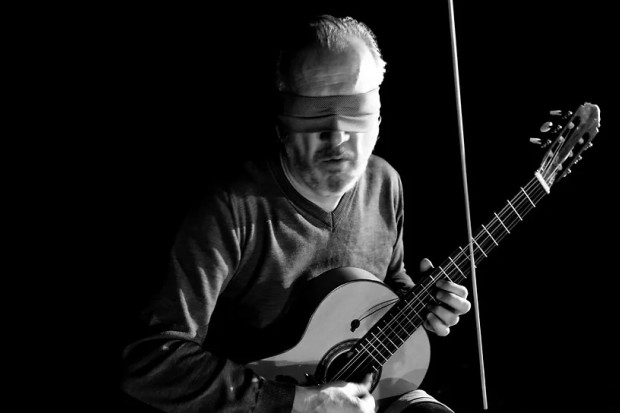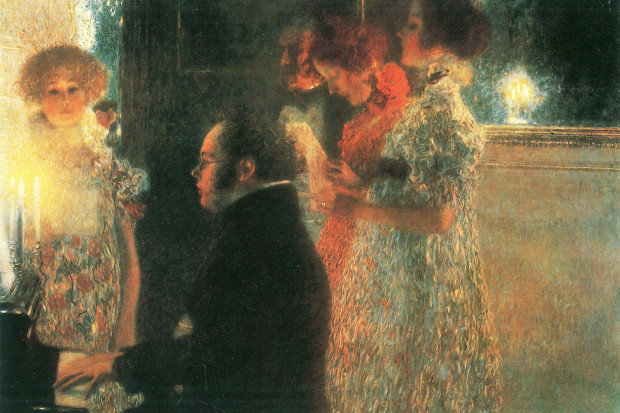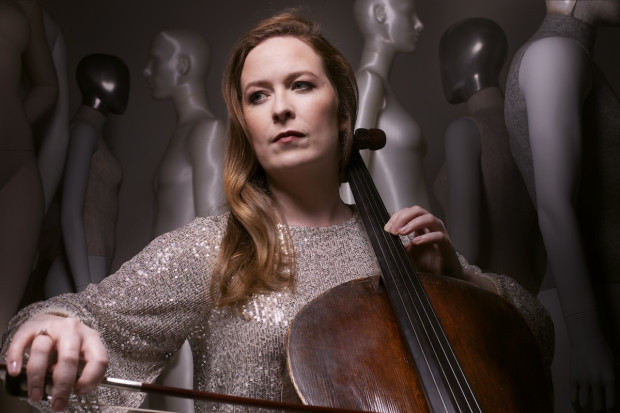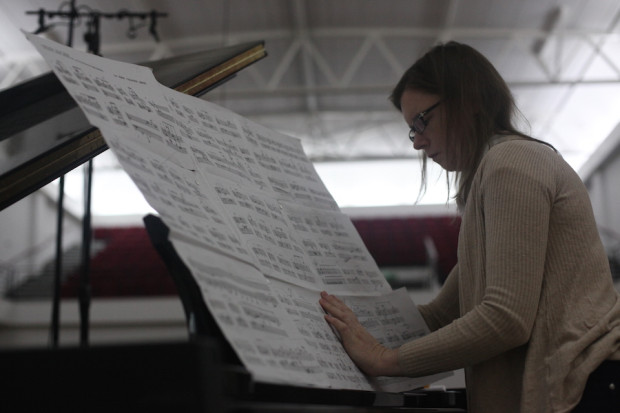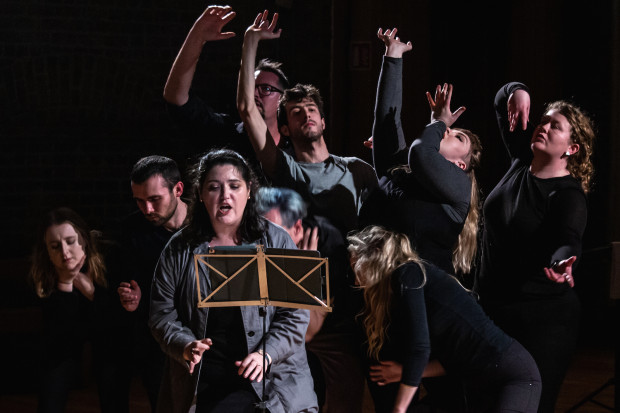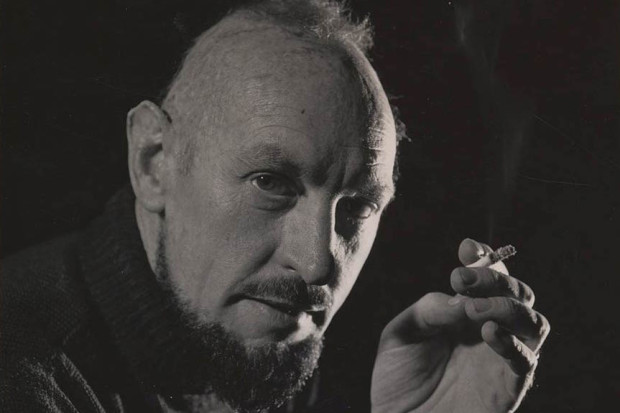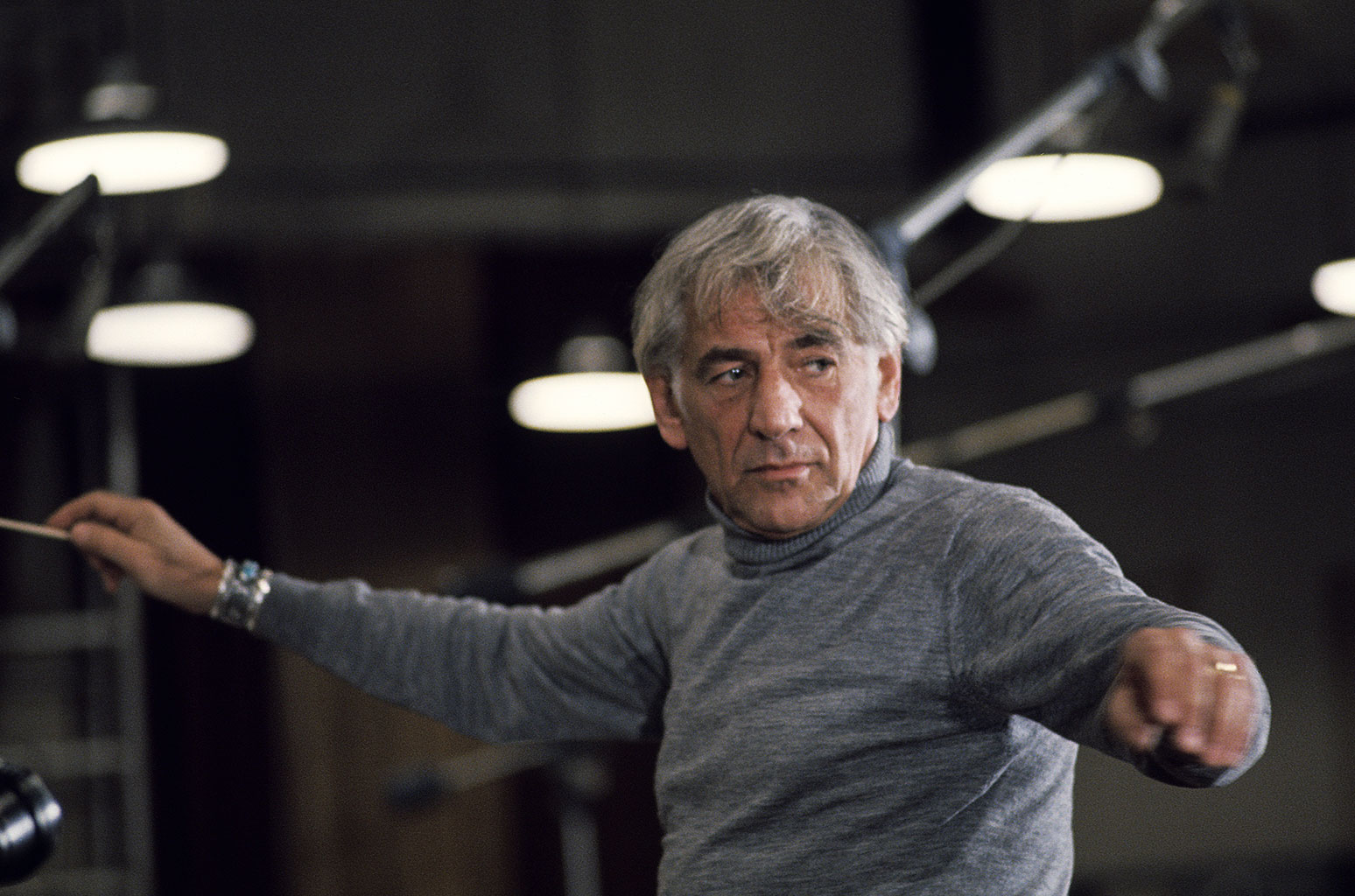
Leonard Bernstein recording in 1974 (Picture: Santi Visalli)
A Love of Music Making
Leonard Bernstein, whose centenary we celebrate this year, was a musical omnivore; he was an exceptional conductor, composer, concert pianist and teacher. And because he excelled so much in all these areas he was also one of the most significant cultural figures in the United States and further afield for most of the latter half of the 20th century. Musicians of my generation grew up on Bernstein. He seemed to me to be a classical musician that performed and experienced music the way rock musicians did – when he conducted he wanted to extract every single drop of elation and pleasure from the moment. He was someone who sought out the ecstasy in music. This was in stark contrast to the more sober and austere (though equally brilliant) Herbert von Karajan, who seemed to embody a European nemesis to the American showman.
That his career (like Karajan’s) coincided with the halcyon days of television and the recording industry was a considerable factor in his universal exposure. Younger generations of musicians today are likely to know his name, of course, but probably unlikely to understand just how influential an artist he was. It is thought that his archive at the Library of Congress lists about 400,000 items including, recordings, films, scores and correspondence. And because mid-century was so amenable to Bernstein’s personality-led model for classical music performance, he was in many respects almost as famous as popular American icons; he was certainly the first classical music conductor and composer who did not look out of place in the company of Sinatra and the Rat Pack.
Instinctive grasp of composition
Leonard Bernstein was the son of Russian and Ukrainian Jewish émigrés who moved to Massachusetts – his grandfather on his father’s side was the last in a long line of Rabbi scholars. Typical of hardworking immigrants in a new land trying to create a new life, Bernstein’s father had little interest in his son becoming a musician. That said, music seemed to come to him, and the local Hebrew temple, where his father subsequently became an important member, hired a choral conductor, Solomon Braslavsky, who would become Bernstein’s first music teacher. Following these early tutorials, Bernstein’s exceptional ear for music and instinctive grasp of composition became apparent from about the age of twelve, and his entry into prestigious educational centres was swift. Enrolment in the New England Conservatory led to his first public performance as a pianist performing Brahms’ Rhapsody in G minor at the age of fourteen. That same year he started new piano classes with Helen Coates (who went on to become his lifelong friend and secretary). Within two years, Bernstein performed Grieg’s Piano Concerto with the Boston Public School Symphony. The following year he was accepted into Harvard.
Harvard gave Bernstein all the grounding he needed in terms of understanding and interpreting the major works of the classical repertory, and he was soon performing works as advanced as Ravel’s Concerto in G minor, Gershwin’s Rhapsody in Blue, and music by Bach, Chopin and Debussy. The young pianist was also an accomplished improviser; to make money as a student, he often played for silent films – one memorable occasion occurred when he got a standing ovation for improvising through an entire showing of Eisenstein’s Battleship Potemkin.
A tectonic shift came when Bernstein heard the renowned Greek conductor and composer Dmitri Mitropoulos directing the Boston Symphony. Their subsequent encounter was the beginning of a very close relationship both musical and personal that was deeply nourishing. The initial access to the secrets of conducting that Bernstein received from the charismatic Mitropoulos was built upon when the former was admitted to the Curtis Institute of Music to study with Fritz Reiner, one of the most prominent conductors of the period. Curtis Institute was a rather more professional-orientated environment and a contrast to the cerebral preoccupations of Harvard. It prepared him more specifically for a life in music. By the time he completed his studies there, Bernstein was performing works such as Scriabin’s Fifth Sonata, and conducting, among other music, Brahms’s Serenade No. 2.
Musical father figures
So despite his father’s misgivings, Bernstein’s natural gifts for music accelerated him to the higher echelons of the music world in America rather quickly. By 1943, both Serge Koussevitzky and Aaron Copeland, two of the leading names in American music at the time, became musical father figures, each attending to Bernstein’s separate talents as conductor and composer, respectively. That same year, Bernstein’s now infamous debut with the New York Philharmonic took place when, at short notice, he had to replace a sick Bruno Walter. It was a singular success; and when the concert finished, both audience and orchestra members were on their feet applauding. The New York Times even put the story on its front page. This was the beginning of an extraordinary professional career lasting over forty-five years.
What fascinates me most about this long period at the helm of international conducting is the tremendous impact Bernstein had on the reception of certain music and composers. It’s not surprising that from the start, he was a strong advocate of American music. What is more remarkable is that he was a major force in the positive re-appraisal of Mahler in the second half of the 20th century. It seems hard to imagine from our current perspective that, from the period of his death in 1910 until well into the 20th century, Mahler’s music was the focus of an extraordinary amount of negative criticism. Not surprisingly, during the Second World War he was explicitly denounced by Nazis throughout Germany and its satellites; but perhaps more disturbingly, he was also widely denigrated by critics from both Europe and America who attempted to highlight perceived weaknesses of structure, design and character (both musical and personal) in critiques that often amounted to little more than dog-whistle anti-Semitism. It is in this context that Bernstein’s advocacy of Mahler takes on political as well as aesthetic importance.
For the centenary of Mahler’s birth in 1960 (and the fiftieth anniversary of his first season as director of the New York Philharmonic), Bernstein created with the same orchestra a festival that programmed every Symphony and numerous song cycles. He would later be the first conductor to record a complete set of all the symphonies. Bernstein rightly saw in Mahler’s music a reflection of the complexities of 20th-century life, its contradictions and aporias, and alongside Bruno Walter, was a major force in bringing Mahler’s music into the centre of the orchestral repertory worldwide.
Though it is not often recognised, Bernstein was also an enthusiastic advocate of new music. Among the works championed by him include Boulez’s Improvisation sur Mallarmé (the American premiere of what later became the second part of Pli selon pli); Varèse’s Déserts; the US premiere of Ligeti’s Atmosphères and Xenakis’ Pithoprakta; Cage’s Atlas Eclipticalis; Rzewski’s Attica; Earle Brown’s Available Forms II (co-conducted with the composer); Milton Babbitt’s Relata II; Elliott Carter’s Concerto for Orchestra; and, of course, Berio’s Sinfonia. An attempt to programme Stockhausen’s Gruppen für drei Orchester was unsuccessful only due to spatial limitations at Carnegie Hall. By any assessment, this is a very respectable record of support for new music with an American orchestra and social milieu that were, for the most part, rather conservative.
Composer, performer, educator
Bernstein’s unique position as a conductor, composer, pianist and teacher meant that at various different moments of his career he was able to make pioneering changes that impacted various aspects of music making and production. It remains something of a rarity that the same person could create a Broadway musical like West Side Story; deliver the Harvard Lectures; perform regularly as a classical pianist with numerous orchestras and string quartets; compose more serious concert music such as symphonies and chamber music; and still have the time, charisma and breadth of vision to become one of the most important and much-loved music educators through his famous Young People’s Concerts series at Carnegie Hall, which was filmed and broadcast throughout America.
But there were numerous drawbacks also. Bernstein leaned well to the left politically. His opposition to the Spanish dictator Franco, for example, was in stark contrast to America’s official stance. And he freely attended functions alongside Paul Robeson, Billie Holiday and Lena Horne. But it was probably his membership of organisations such as the Council on African Affairs, the National Negro Congress and the National Council of American-Soviet Friendship that put him most at risk of investigation by the powerful House Un-American Activities Committee and Senator Joseph McCarthy, so that by 1946 he was declared ‘a Communist’, even though he was never a member of the Communist Party. This pressure on Bernstein lasted many years.
Political affiliations
There are real complications here, however, when we come to understand Bernstein’s position and dilemma. When in 1953, the US Passport Office refused to re-issue his passport, and with an important debut at La Scala imminent, Bernstein decided to sign an affidavit distancing himself from all his previous close attachments to certain causes and personalities, and openly admitted that he was a ‘foe of communism’. While some might see this as merely an empty formula, it is also true that it represented an absolute betrayal of both his own previously held political affiliations and of those with whom he once stood shoulder to shoulder. Does this point to a man in an impossible situation, or does it expose a musician who would do anything to ensure his necessary rise to the top? Perhaps both. Whatever internal conflictions Bernstein experienced, the signing of the affidavit had its desired effect: it led to his successful debut at La Scala, and opened the doors to his involvement as composer in the film On the Waterfront. While friends were left behind, the future beckoned.
There were further dichotomies in Bernstein’s actions. In 1947, he and his family visited Palestine (still a British protectorate). At this very moment, the country was enveloped in violence on all sides, not least the militant wing of the Zionist movement. It is hard to reconcile Bernstein’s public avowal of pacifism and humanitarianism on the one hand, and his staunch support of Zionism on the other, particularly at this violent stage in the country’s rapidly changing history, which was witnessing levels of ethnic cleansing not seen since the Second World War. In this regard, Bernstein aligned himself with so many other ‘liberal’ Americans who placed the Palestine question in a silo separate from the rest of their broadly liberal positions.
Bernstein went on at later stages of his career to maintain support for various left-wing initiatives. Going beyond simple affiliation with the Democrats (he was a friend of the Kennedy’s, and refused an award from Bush Senior), he seems to have been fully aware of the military-industrial complex at the core of American government policy making, and continued his support of marginalized people and organizations (even of a quasi-militant nature). In the late 1960s, for example, he is on record as saying that the present is ‘a crisis of world revolution… based on the right to eat. And we of the West, who insist on the right to eat at other people’s expense, seem to be doing everything we know to prevent this revolution taking place.’ Felicia Montealegre, his wife, was also a strong activist for numerous left-wing causes, and she and Bernstein attracted heat from their association (often distorted by right-wing journalists such as Tom Wolfe and William Buckley) with those such as the Black Panthers and anti-Vietnam war protesters the ‘Harrison Seven’. Such advocacy certainly points to a deeply embedded affiliation to liberal, progressive politics, in as much as such terms can mean anything in America.
West Side Story and Harvard Lectures
Leaving politics aside, Bernstein’s reach certainly extended beyond America. As I mentioned earlier, those of my generation saw him as the flamboyant conductor and composer. But there are three areas of Bernstein’s art that touched me more personally and profoundly. The first was seeing, at perhaps the age of ten or eleven, the film version of West Side Story. This remains a powerful memory for me. I can still vividly recall the way in which the pathos of ‘Maria’ and the barely contained violent undertones of ‘Cool’ were made so palpable by the music. The exciting metrical interplay, syncopation and ‘hemiola’ rhythms of ‘America’ were infectious, and would be an early lesson in the rhythmic structures of so much Spanish and South American music I would later come to perform as a classical guitarist.
The second element that struck me was a performance of Shostakovich’s Symphony No. 5 in a live recording with the New York Philharmonic from 1959. I listened to that recording for years, and still (perhaps subconsciously) rate all other recordings of the work against it. For me, this utterly intense interpretation burnt Shostakovich into my musical consciousness. It was also an object lesson in the role interpreters play in the communication of musical forms; the lesson specifically was that the commitment to performance needs to be total, music needs to be lived through performance and performance needs to live through music, not for passive, bourgeois pleasure but as a way of making music matter in life, to offer new visions of life through music. This was a vital lesson for a young musician.
The third is Bernstein’s Harvard lectures, which I first came across in a television broadcast (I recorded them all on VHS tape!). Of course I was a little sceptical of Bernstein’s obvious ego, the wry, knowing smile and the constant flicking of hair. But he also had this natural and convincing way of getting his ideas across that was very genuine. I had just become interested in composition, and his resituating of Chomskian linguistics within a music framework fascinated me (though, of course, I didn’t yet know who Chomsky was). I was particularly taken by his comparison between music and text. Using Shakespeare’s Romeo and Juliet, he demonstrated that language had to exist more metaphorically, less denotationally, in order to elevate itself to the poetic level—‘Juliet is the sun’; whereas music already exists on that wonderfully ambiguous and metaphoric level; music was already poetic. It doesn’t matter that from my present perspective Bernstein’s attempts to use generative linguistics as a means of explaining music’s internal mechanisms seems quite flawed and, in fact, misplaced. The point is that access to his ideas at that early stage of my development as a composer and musician made me really think deeply about music and its relationship with language; and for that alone I am very grateful.
Ultimate musician
Looking back on Bernstein’s contribution to music we see a personality driven by a love for every element of music making. For one who specialised in so much it is perhaps not surprising that some inconsistencies appear. From our objective, 21st-century distance, we can state without sounding needlessly unkind that Bernstein was perhaps not among the first league of composers. And while he was an excellent pianist, the various demands of his diverse career cut into the time and dedication required to become a world-class pianist. His conducting, however, will remain his lasting influence, and few would dispute his eminence in this regard.
There is another view of Bernstein (again, from a personal perspective) that I think is very important. This is that he represents what might be described as the ultimate musician. He was one in a line of such musicians from Bach, to Liszt, to Mahler, who created music from the perspective of the performer-composer-teacher matrix. For much of the latter half of the 20th century music was taught as so many discipline-specific modules – performance, conducting, teaching, musicology – and in that specialisation young musicians had often been ring-fenced; excelling in one area of music but often rather limited or even ignorant of other vital elements. Bernstein has shown us unequivocally that music is a thoroughly holistic affair; the composer should play, the player should compose – each discipline feeds positively into the other; and so total immersion in music is the way. And, thankfully, we are beginning to see this broader, inclusive model being employed more often in the contemporary conservatoire and university. In this sense, Bernstein was not only a man of his time but also a man ahead of his time.
Benjamin Dwyer will discuss Leonard Bernstein on The History Show on RTÉ Radio 1 on Sunday 21 October 2018 at 6pm. Listen at https://www.rte.ie/radio1.
Published on 18 October 2018
Benjamin Dwyer is a guitarist and composer and the author of 'Different Voices: Irish Music and Music in Ireland'. He is Professor of Music at Middlesex University's Faculty of Arts and Creative Industries.












